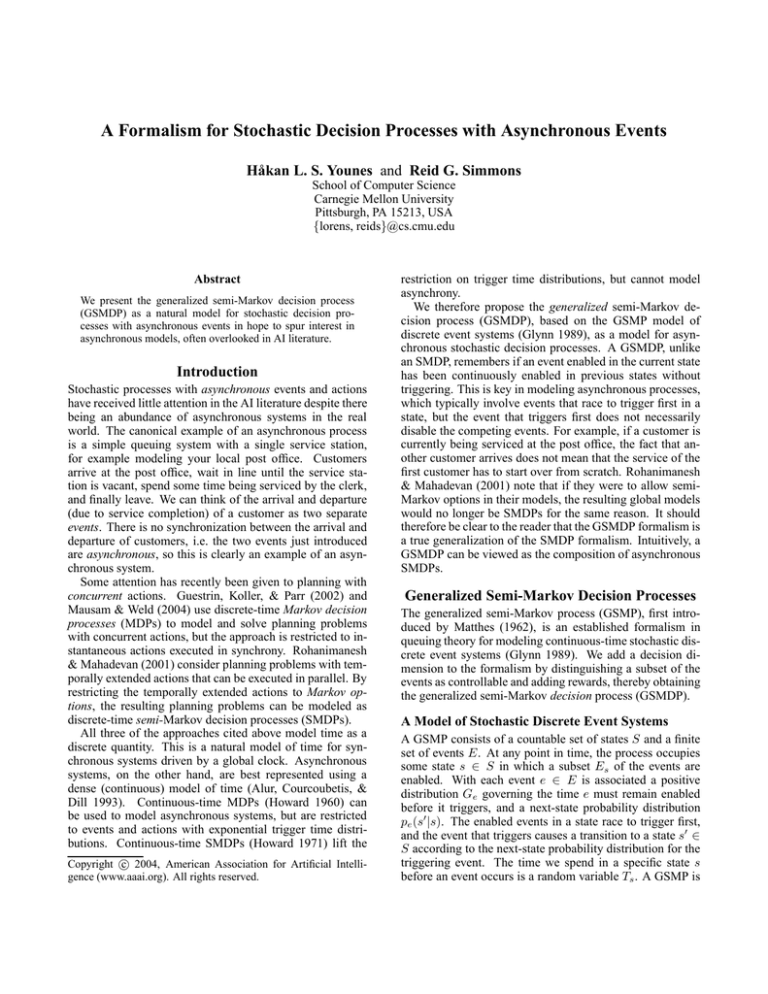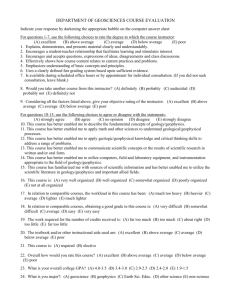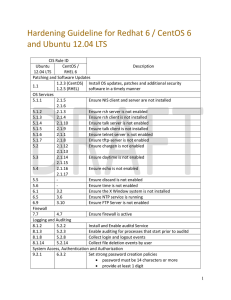
A Formalism for Stochastic Decision Processes with Asynchronous Events
Håkan L. S. Younes and Reid G. Simmons
School of Computer Science
Carnegie Mellon University
Pittsburgh, PA 15213, USA
{lorens, reids}@cs.cmu.edu
Abstract
We present the generalized semi-Markov decision process
(GSMDP) as a natural model for stochastic decision processes with asynchronous events in hope to spur interest in
asynchronous models, often overlooked in AI literature.
Introduction
Stochastic processes with asynchronous events and actions
have received little attention in the AI literature despite there
being an abundance of asynchronous systems in the real
world. The canonical example of an asynchronous process
is a simple queuing system with a single service station,
for example modeling your local post office. Customers
arrive at the post office, wait in line until the service station is vacant, spend some time being serviced by the clerk,
and finally leave. We can think of the arrival and departure
(due to service completion) of a customer as two separate
events. There is no synchronization between the arrival and
departure of customers, i.e. the two events just introduced
are asynchronous, so this is clearly an example of an asynchronous system.
Some attention has recently been given to planning with
concurrent actions. Guestrin, Koller, & Parr (2002) and
Mausam & Weld (2004) use discrete-time Markov decision
processes (MDPs) to model and solve planning problems
with concurrent actions, but the approach is restricted to instantaneous actions executed in synchrony. Rohanimanesh
& Mahadevan (2001) consider planning problems with temporally extended actions that can be executed in parallel. By
restricting the temporally extended actions to Markov options, the resulting planning problems can be modeled as
discrete-time semi-Markov decision processes (SMDPs).
All three of the approaches cited above model time as a
discrete quantity. This is a natural model of time for synchronous systems driven by a global clock. Asynchronous
systems, on the other hand, are best represented using a
dense (continuous) model of time (Alur, Courcoubetis, &
Dill 1993). Continuous-time MDPs (Howard 1960) can
be used to model asynchronous systems, but are restricted
to events and actions with exponential trigger time distributions. Continuous-time SMDPs (Howard 1971) lift the
c 2004, American Association for Artificial IntelliCopyright gence (www.aaai.org). All rights reserved.
restriction on trigger time distributions, but cannot model
asynchrony.
We therefore propose the generalized semi-Markov decision process (GSMDP), based on the GSMP model of
discrete event systems (Glynn 1989), as a model for asynchronous stochastic decision processes. A GSMDP, unlike
an SMDP, remembers if an event enabled in the current state
has been continuously enabled in previous states without
triggering. This is key in modeling asynchronous processes,
which typically involve events that race to trigger first in a
state, but the event that triggers first does not necessarily
disable the competing events. For example, if a customer is
currently being serviced at the post office, the fact that another customer arrives does not mean that the service of the
first customer has to start over from scratch. Rohanimanesh
& Mahadevan (2001) note that if they were to allow semiMarkov options in their models, the resulting global models
would no longer be SMDPs for the same reason. It should
therefore be clear to the reader that the GSMDP formalism is
a true generalization of the SMDP formalism. Intuitively, a
GSMDP can be viewed as the composition of asynchronous
SMDPs.
Generalized Semi-Markov Decision Processes
The generalized semi-Markov process (GSMP), first introduced by Matthes (1962), is an established formalism in
queuing theory for modeling continuous-time stochastic discrete event systems (Glynn 1989). We add a decision dimension to the formalism by distinguishing a subset of the
events as controllable and adding rewards, thereby obtaining
the generalized semi-Markov decision process (GSMDP).
A Model of Stochastic Discrete Event Systems
A GSMP consists of a countable set of states S and a finite
set of events E. At any point in time, the process occupies
some state s ∈ S in which a subset Es of the events are
enabled. With each event e ∈ E is associated a positive
distribution Ge governing the time e must remain enabled
before it triggers, and a next-state probability distribution
pe (s0 |s). The enabled events in a state race to trigger first,
and the event that triggers causes a transition to a state s0 ∈
S according to the next-state probability distribution for the
triggering event. The time we spend in a specific state s
before an event occurs is a random variable Ts . A GSMP is
a semi-Markov process only if the distribution of Ts , for all
s ∈ S, is independent of history.
As an example of a GSMP, consider the post office “system” mentioned in the introduction. The state of this simple
queuing system is the number of customers currently in the
post office. There are two events representing customer arrival and customer departure, respectively. The arrival event
is always enabled and the distribution associated with this
event represents the inter-arrival time for customers. The
departure event is only enabled when there are customers in
the post office. The distribution associated with the departure event represents the time it takes to service a single customer. When the departure event triggers, the state changes
from n to n − 1. The arrival event causes a transition from
state n to n + 1, unless the post office is full in which case
the state does not change.
Formal Semantics. To formally define the semantics of a
GSMP model, we associate a real-valued clock te with each
event that indicates the time remaining until e is scheduled
to trigger in the current state. The process starts in some initial state s with events Es enabled. For each enabled event
e ∈ Es , we sample a trigger time according to the distribution Ge and set te to the sampled value. For disabled
events, we set te = ∞. Let e∗ be the event in Es with the
smallest clock value, i.e. e∗ = arg mine∈Es te . The event
e∗ becomes the triggering event in s. Provided that all trigger time distributions are continuous, the probability of two
events triggering at exactly the same time is zero so e∗ is
uniquely defined. When e∗ triggers after te∗ time units in s,
we sample a next state s0 according to pe∗ (s0 |s) and update
each clock te as follows:
1. if e ∈ Es0 ∩ {e∗ } ∪ E \ Es , then t0e is sampled from
Ge ;
2. if e ∈ Es0 ∩ Es \ {e∗ } , then t0e = te − te∗ ;
3. otherwise, if e 6∈ Es0 then t0e = ∞.
The first rule covers events that are enabled in s0 and either triggered or were not enabled in s. All such events are
rescheduled. Events that remain enabled across state transitions without triggering are not rescheduled (rule 2). It is this
rule that introduces history dependence and therefore breaks
the semi-Markov property, thus a GSMP is not necessarily
a semi-Markov process. The third and final rule states that
events disabled in s0 are scheduled not to trigger. Given a
new state s0 and new clock values t0e for each e ∈ E, we
repeat the procedure just specified with s = s0 and te = t0e
so long as Es 6= ∅.
By adding the clocks to the description of states we ob|E|
tain an extended state-space X ⊂ S × R≥0 . Given an
extended state x ∈ X, the next-state distribution over X
is well-defined, which means that we can define a Markov
chain with state-space X that corresponds to a GSMP with
state-space S. This will be a general state-space Markov
chain (GSSMC; Shedler 1993) because the state-space has
both discrete and continuous components. Let fe (t) be the
probability density function for the distribution Ge associated with event e. The next-state distribution for the GSSMC
is defined as f (x0 |x) = pe∗ (s0 |s)
f˜e (t0e |s0 , x) is
Q
e∈E
f˜e (t0e |s0 , x), where
1. fe (t0e ), if e ∈ Es0 ∩ {e∗ } ∪ E \ Es ;
2. δ(t0e − (te − te∗ )), if e ∈ Es0 ∩ Es \ {e∗ } ;
3. δ(t0e − ∞), if e 6∈ Es0 .
Here, δ(t − t0 ) is the DiracR delta function (Dirac 1927, p.
x
625) with the property that −∞ δ(t − t0 )dt is 0 for x < t0
Rx
and 1 for x ≥ t0 . In particular, −∞ δ(t − ∞)dt is 0 for any
finite x and 1 for x = ∞.
Observation Model. In general, the future trigger times of
enabled events are not known to an observer of the process.
Only the discrete part of the state-space is fully observable.
However, the time that an event has been enabled is know to
an observer, and this information is sufficient to provide the
observer with a probability distribution over extended states.
|E|
Let O ⊂ S × R≥0 be the set of observations. An observation o = hs, ~ui ∈ O consists of s, the observed discrete
part of the current extended state, and a vector ~u with elements ue for each e ∈ E being the time that event e has
been enabled (ue = 0 if e 6∈ Es ). Given an observation
o = hs, ~ui, a probability density function f (x|o) over X is
Q
defined as f (x|o) = e∈E f˜e (te |te > ue , s) if x = hs, ~ti
and f (x|o) = 0 otherwise, where f˜e (te |te > ue , s) is
fe (te |te > ue ) if e ∈ Es and δ(te − ∞) otherwise.
Clearly, ue is only significant for e ∈ Es . Furthermore,
if the distribution Ge associated with e is memoryless, i.e.
fe (t|t > t0 ) = fe (t) as is the case for the exponential distribution, we do not need to know for how long e has been
enabled. Thus, an observation only needs to consist of s and
ue for all e ∈ Es such that Ge is not a memoryless distribution. A GSMP with all events associated with an exponential distribution is simply a continuous-time Markov chain
(Glynn 1989).
We define a function obs : X × O × S → O that given
an extended state x, an observation of x, and the observable
part s0 of a successor x0 of x, provides the observation of
x0 . We have obs(x, o, s0 ) = hs0 , ~u0 i, where ~u0 consists of
elements u0e for each e ∈ E, with u0e being
1. ue + te∗ , if e ∈ Es0 ∩ Es \ {e∗ } ;
2. 0 otherwise.
The first case covers events that remain enabled across state
transitions without triggering. The time that e has remained
enabled is simply the time it had remained enabled when entering state s (ue ) plus the time spent in s (te∗ ). The second
case covers events that were not previously enabled or just
triggered. Clearly, these events have not been enabled without triggering so the observation is 0 in this case. Note that
the continuous component of x0 is irrelevant to the observation of x0 .
We could of course record the time an event has been enabled in the extended state rather than the trigger time of
the event. An extended state would in that case be fully observable, but the result would be a general state-space semiMarkov process instead of a Markov chain.
vαπ (o)
Z
=
f (x|o)
X
Z
=
X
vαπ (s) =
Zte∗
Z∞
e
−αt
−αte∗
Z
c(s, π(o))dt + e
0
0
∗
0
f (x |x, o) k(s, e , s ) +
vαπ (obs(x, o, s0 ))
!
0
dx dx
X
!
X
1
1 − e−αte∗ c(s, π(o)) + e−αte∗ k̂(s, e∗ ) +
f (x|o)
pe∗ (s0 |s)vαπ (obs(x, o, s0 ))
dx
α
0
(1)
s ∈S
λπs e
!
X
1
1 − e−αt c(s, π(s)) + e−αt k̂(s, e) +
pe (s0 |s)vαπ (obs(s0 ))
dt
α
0
e∈Es
s ∈S
!
X
X 0
π
0
c(s, π(s)) +
λe k̂(s, e) +
pe (s |s)vα (obs(s ))
−λπ
st
0
1
= π
λs + α
X λe
λπs
π
e∈Esπ
Actions, Policies, and Rewards
Given a GSMP with event set E, we identify a set A ⊂ E
of controllable events, or actions. The remaining events
are called exogenous events. Actions differ from exogenous events in that they can be disabled at will in a state,
while an exogenous event e always remains enabled in a
state s if e ∈ Es . A control policy π determines which
actions should be enabled at a given time in a state. We
allow the action choice to depend on the entire execution
history of the process, which can be captured in an observation o ∈ O as described above. Thus, a policy is a mapping from observations to sets of actions: π : O → 2A . A
GSMDP controlled by a policy π isa GSSMC with Es replaced by E π (o) = π(o) ∪ Es \ A in the definition of e∗ ,
f (x|o), and obs(x, o, s0 ). The next-state distribution is redeQ
fined as f (x0 |x, o) = pe∗ (s0 |s) e∈E f˜e (t0e |s0 , x, o), where
f˜e (t0e |s0 , x, o) is defined as f˜e (t0e |s0 , x) with E π (o) replacing
π
Es and Eobs(x,o,s
0 ) replacing Es0 .
For the post office example, we could make the departure
event into an action. This would signify that we can open
and close the service station at will. If we close the service
station (i.e. disable the departure event) while a customer is
being serviced, the time we have spent with the customer
is forgotten and the customer must be serviced from scratch
if we reopen the service station (i.e. enable the departure
event).
In addition to actions, we specify a reward structure to
obtain a GSMDP. We assume a traditional reward structure
with a lump sum reward k(s, e, s0 ) associated with the transition from state s to s0 caused by the triggering of event e,
and a continuous reward rate c(s, A0 ) associated with set of
actions A0 ⊂ A being enabled in s (cf. Puterman 1994). The
expected lump sum reward if event e triggers in state s is
P
k̂(s, e) = s0 ∈S pe (s0 |s)k(s, e, s0 ).
The expected infinite-horizon discounted value of an observation o for a policy π is given by (1). The parameter
α is the discount rate, which can be interpreted as the rate
of a termination event with exponential trigger time distribution (Howard 1960). It means that a unit reward earned t
time units into the future counts as a e−αt reward at present
time. Note that if rewards were allowed to depend on the ex-
(2)
s0 ∈S
tended state x of the process, and not only on the real state
s, we would not be able to get rid of the nested integrations
in (1).
Now, let s be a state such that each event e ∈ Esπ is
associated with an exponential
P distribution having rate λe :
Ge = Exp(λe ). Let λπs = e∈E π λe . The time spent in s
s
before an event triggers is then a random variable with distribution Exp(λπs ) and the probability that a specific event
e triggers first is λe /λπs . These nice properties of the exponential distribution allows us to write the expected infinitehorizon discounted value of s as (2). We write obs(s0 ) for
the observation of the next state because it is independent
of the current state. If all events are associated with memoryless distributions, then obs(s0 ) can be replaced with s0
in (2), which then represents an alternative formulation for
continuous-time Markov decision processes.
Discussion
Unless we make limiting assumptions regarding a GSMDP
model, for example that all distributions are memoryless,
then we most likely have to resort to approximation schemes
in order to solve the GSMDP. A straightforward approach
would be to discretize time, however, we will suffer greatly
from the curse of dimensionality if we do so naively.
Younes & Simmons (2004) present a technique for approximating a GSMDP with a continuous-time MDP by approximating each distribution Ge with a continuous phasetype distribution (Neuts 1981). The continuous-time MDP
can then be solved using standard techniques. The approximation essentially amounts to a discretization into randomlength intervals of the observation for how long an event has
been enabled. The length of an interval is a random variable
with an exponential distribution.
Alternatively, we could use discrete phase-type distributions (Neuts 1975) to obtain a discrete-time MDP that approximates our GSMDP. Bobbio et al. (2003) describe an algorithm for approximating an arbitrary positive distribution
with a discrete phase-type distribution, which could be used
for the purpose of approximating a GSMDP with a discretetime MDP. One clear advantage with this approach over using continuous phase-type distributions is that determinis-
tic distributions can be represented exactly. A disadvantage
with approximating a GSMDP with a discrete-time model
is that we would have to take into account the possibility of
two events triggering at the same time, and it may not be
immediately obvious what to do in such a case.
A third possibility is of course to use a function approximator, for example k-nearest neighbor, to represent the value
function of a GSMDP. The GSMDP could then be solved using fitted value iteration (Gordon 1995).
Even if we cannot hope to find optimal policies for
GSMDPs, it may still be worthwhile trying to determine
characteristics of optimal policies. We have defined a policy
as a mapping from observations to sets of actions, where an
observation includes a clock value for each enabled event.
This means that actions can be enabled and disabled at any
point in time while in a specific state and not only at the
triggering of an event or action. If all trigger time distributions are exponential, i.e. if the GSMDP is a continuoustime MDP, then we do not need to take into consideration
the time that events have been enabled in order to maximize
the expected infinite-horizon discounted reward. The SMDP
case, when the action choice can change between transition,
has been analyzed by Chitgopekar (1969), Stone (1973), and
Cantaluppi (1984) under various assumptions. An analysis
of this sort would be valuable for the general case with asynchronous events as well, and would ideally provide us with
conditions for the trigger time distributions under which the
optimal policy has a certain structure (for example piecewise
constant).
References
Alur, R.; Courcoubetis, C.; and Dill, D. 1993. Modelchecking in dense real-time. Information and Computation
104(1):2–34.
Bobbio, A.; Horváth, A.; Scrapa, M.; and Telek, M. 2003.
Acyclic discrete phase type distributions: Properties and a
parameter estimation algorithm. Performance Evaluation
54(1):1–32.
Cantaluppi, L. 1984. Optimality of piecewise-constant
policies in semi-Markov decision chains. SIAM Journal
on Control and Optimization 22(5):723–739.
Chitgopekar, S. S. 1969. Continuous time Markovian
sequential control processes. SIAM Journal on Control
7(3):367–389.
Dirac, P. A. M. 1927. The physical interpretation of the
quantum dynamics. Proceedings of the Royal Society of
London. Series A 113(765):621–641.
Glynn, P. W. 1989. A GSMP formalism for discrete event
systems. Proceedings of the IEEE 77(1):14–23.
Gordon, G. J. 1995. Stable function approximation in dynamic programming. In Proc. Twelfth International Conference on Machine Learning, 261–268. Morgan Kaufmann Publishers.
Guestrin, C.; Koller, D.; and Parr, R. 2002. Multiagent
planning with factored MDPs. In Advances in Neural Information Processing Systems 14: Proc. 2001 Conference.
Cambridge, MA: The MIT Press. 1523–1530.
Howard, R. A. 1960. Dynamic Programming and Markov
Processes. New York, NY: John Wiley & Sons.
Howard, R. A. 1971. Dynamic Probabilistic Systems, volume II. New York, NY: John Wiley & Sons.
Matthes, K. 1962. Zur Theorie der Bedienungsprozesse.
In Trans. Third Prague Conference on Information Theory,
Statistical Decision Functions, Random Processes, 513–
528. Publishing House of the Czechoslovak Academy of
Sciences.
Mausam, and Weld, D. S. 2004. Solving concurrent
Markov decision processes. In Proc. Nineteenth National
Conference on Artificial Intelligence. AAAI Press.
Neuts, M. F. 1975. Probability distributions of phase type.
In Liber Amicorum Professor emeritus dr. H. Florin. Leuven, Belgium: Katholieke Universiteit Leuven. 173–206.
Neuts, M. F. 1981. Matrix-Geometric Solutions in Stochastic Models: An Algorithmic Approach. Baltimore, MD:
Johns Hopkins University Press.
Puterman, M. L. 1994. Markov Decision Processes: Discrete Stochastic Dynamic Programming. New York, NY:
John Wiley & Sons.
Rohanimanesh, K., and Mahadevan, S. 2001. Decisiontheoretic planning with concurrent temporally extended actions. In Proc. Seventeenth Conference on Uncertainty in
Artificial Intelligence, 472–479. Morgan Kaufmann Publishers.
Shedler, G. S. 1993. Regenerative Stochastic Simulation.
Boston, MA: Academic Press.
Stone, L. D. 1973. Necessary and sufficient conditions
for optimal control of semi-Markov jump processes. SIAM
Journal on Control 11(2):187–201.
Younes, H. L. S., and Simmons, R. G. 2004. Solving
generalized semi-markov decision processes using continuous phase-type distributions. In Proc. Nineteenth National Conference on Artificial Intelligence. AAAI Press.





